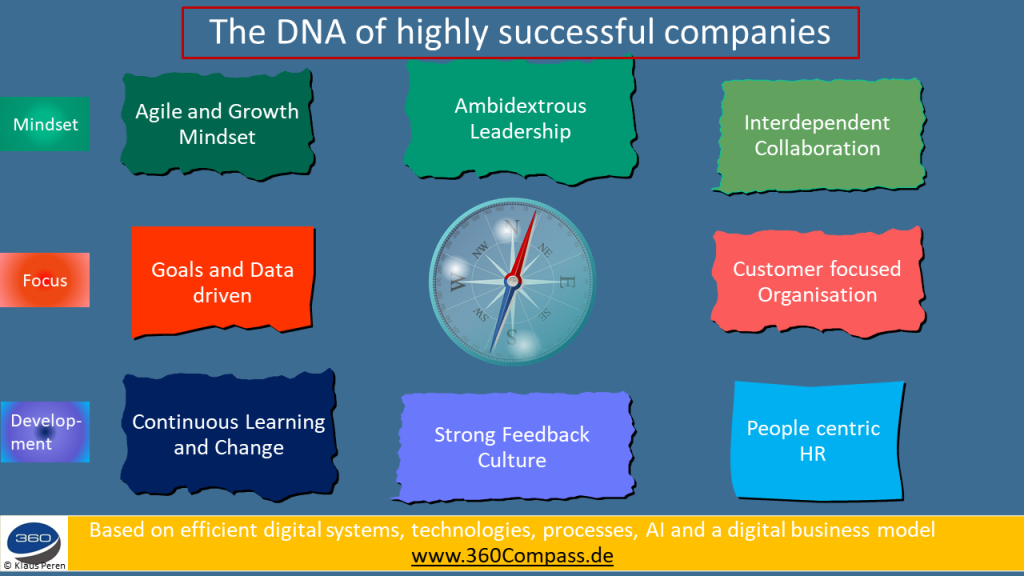What makes very successful companies? Difficult question, because every company is different in terms of size, economic sector, business model, corporate culture, age, socio-cultural environment….. Let’s look at the challenges, but there are many similarities: rapid technical development, digitization, and the restructuring of the economy towards sustainability and climate neutrality, Ukraine war affect almost all companies. All this in times of a pandemic that no one can say today how long it will burden us. And in many Western countries, we have a demographic development that will lead to even more bottlenecks for relevant labour market segments in the coming years.
Where challenges are similar, there are strategies or, in other words, principles on how companies successfully master these challenges. I called this „the DNA of very successful companies“. In addition to my personal experiences, I refer to research of business literature, intended as a stimulus for reflection or positioning.
Successful companies drive digital change at the level of systems, technologies, processes and use the advantages of artificial intelligence. Already in the 80s of the last century, we learned with the productivity paradox that the investment in new IT hardware and software is no guarantee for higher productivity and business success. However, the already difficult task of the technical dimension of digitization is only the basis for success, today we know that soft factors are also decisive. It is about a new mindset, focus and continuous development or development. If you dive deeper into these success factors it´s about the 8 points from the diagram in these three „layers“, from my perspective.
This article is about mindset, later about focus and development.

Agile and Growth Mindset
Mindset as a term means the set of thoughts and attitudes (mind). The values and principles from the Agile Manifesto (Agile Mindset) and the core points from the Growth Mindset, as Carol Dweck described it, belong together for me. Both are similar or complementary principles – e.g., trust and responsibility are the basis of all cooperation and the engine for development in the agile mindset and everyone can positively influence their own development (in the growth mindset). Companies that have anchored this positive thinking in their culture, in their DNA, react faster to changes, are closer to customers and more innovative, also because they work together in a supportive (interdependent) way. In this mindset, the restructuring of the economy towards sustainability succeeds. In addition, I appreciate the consistent alignment with customer needs in the agile mindset.
Interdependent Mindset
In his coaching standard work, John Whitmore describes the maturity of companies[1] with the highest productivity as interdependent. Characteristics of an interdependent cooperation/culture are:
- Teams have a strong sense of ownership for high performance and believe that this can only be achieved by the group.
- People interact with others to understand different points of view and show a high level of trust, care, and cooperation.
- Continuous authentic communication and feedback.
- Collective mentality to believe in one’s own development.
- High awareness and responsibility – for oneself and others.
- Strong coaching culture.
This characterizes a culture in which security is offered, trust is given, and openness is possible – and thus high productivity.
Ambidextrous Leadership
For me, ambidextrous leadership is the key to the digital, but also ecological transformation of our economy. This „ambidextrous“ leadership combines the ability to invest both in the new (business models, markets, customers, sustainable management skills) and at the same time to make maximum use of the existing (markets, customer potential, technologies, workforce) and to combine sustainability with efficient principles. The guiding principle of ambidexterity at Leadership Insiders is[2] formulated:
„Managers should use their resources in such a way that they distribute them wisely to the profit-oriented exploitation of the existing business and to the risky exploration of new products, services, or business models.“
Understood in this way, the simultaneous look ahead, without losing sight of success in the present, is a continuous attitude of development. Ambidextrous Leadership is a mindset for me. On the one hand, managers are aware of this ambidexterity, and they have an inner motivation to continuously develop their own innovative and exploratory and implementation competence. In addition, they have the (growth) mindset, the balancing of often contradictory requirements, to see as chance.
In my view, mindset is the most important factor of very successful companies. I recommend the article from the Harvard Business Review „Leaders Focus Too Much on Changing Policies, and Not Enough on Changing Minds“. [3] What is your opinion on this?
[1] See Side 31, Whitmore, John (2017). Coaching for Performance, Nicholas Brealey Publishing, fifth edition
[2] https://www.leadership-insiders.de/ambidextre-fuehrung/
[3] https://hbr.org/2018/06/leaders-focus-too-much-on-changing-policies-and-not-enough-on-changing-minds?utm_medium=social&utm_campaign=hbr&utm_source=LinkedIn&tpcc=orgsocial_edit

2 Kommentare on “The DNA of very successful companies – Part 1: Mindset”